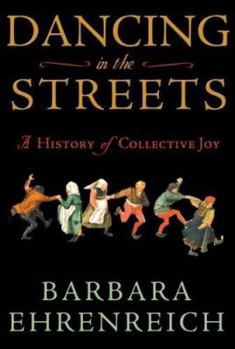Dancing in the Streets: A History of Collective Joy
Select Format
Select Condition 
Book Overview
From the bestselling social commentator and cultural historian comes Barbara Ehrenreich's fascinating exploration of one of humanity's oldest traditions: the celebration of communal joy In the... This description may be from another edition of this product.
Format:Hardcover
Language:English
ISBN:0805057234
ISBN13:9780805057232
Release Date:January 2007
Publisher:Metropolitan Books
Length:320 Pages
Weight:1.40 lbs.
Dimensions:1.1" x 6.4" x 9.4"
Customer Reviews
4 ratings
Excellent book, Well Researched
Published by Thriftbooks.com User , 14 years ago
I listened to the audio version of this book. I found this book to be fascinating and stimulating. As a life-long Roman Catholic, I thought the earlier reviews that decry the author for her 'church bashing' and 'Stalin'-like approaches were rather unfair and unnecessarily ad hominem. The author clearly put a great deal of time and effort into this book (either that, or she has an amazing team of researchers working for her! ;-D). It was fascinating for me to listen as she wove disparate pieces of information into a beautiful tapestry about the history of collective ecstatic dance in the Western world. (These kinds of books are very difficult to write. If you haven't tried to write a book such as this, I would strongly invite you to do so ... you'll gain a new appreciation for authors such as Ehrenreich who make it look so easy.) I picked this book up because I very appreciated the author's Nickel and Dimed: On (Not) Getting By in America and Bait and Switch: The (Futile) Pursuit of the American Dream. I appreciate the author because she is focusing on issues that, in my opinion, should deeply concern today's Christians, such as the rich becoming richer and the poor becoming poorer. As a mental health professional, I also found her discussion on depression and mental health issues to be very insightful. The person who read the audio book did a wonderful job. I found her voice very easy to listen to. The only critique I would offer to the publisher is that I sometimes found it difficult to tell where a particular quote ended and where the text resumed (in several cases knowing where they quote ended made a significant different in understanding the text). For people interested in historical Christianity, collective healing rituals, mental health, dance, martial arts, and other forms of physical movement, I would highly recommend this book.
Social repression explained
Published by Thriftbooks.com User , 15 years ago
This book explains how and why our western European culture (among others) systematically represses our natural human inclination to cut loose and enjoy ourselves, and why it is so important for our emotional and political well-being that we continue to do so! Very thorough in explanations and examples. I now see acts of community celebration, music and dance to be highly important demonstrations of our personal freedom and political rights.
Highly Recommended
Published by Thriftbooks.com User , 17 years ago
I picked up this book purely by chance--the title caught my eye--and I am ever so glad that I did. Not only was it fun to read, but it really made me think and wish to explore these ideas further. The book is well thought out, well written, and definitely pushes the boundaries. The thought that there may be a link between the lack of group festivities/dancing which inspire people to altered states of consciousness (ie profound joy which takes you out of yourself and how you perceive the world) and the rise of depression and anxiety should definitely be explored further. How much better to learn how to achieve ecstasy through giving yourself over to the occasional dance or celebration and having this improve your life and mental status than to pop pills for the rest of your life? One of the other reviewers mentioned something about how the author may have just not paid enough attention to how our celebrations have changed (mentioning something about little girls dressing up to see the play Wicked) but that is not what this book is about, in my opinion. Dressing up and being excited is not the same as going into an ecstatic state in a group situation. You may get excited waiting in line to get the next Harry Potter book, for example, and even be dressed up as a witch or wizard, but unless it sends you into an altered state it is simply not the same thing at all. Overall, I would highly recommend this book. Not just to those interested in history, but to expects in psychology, as well. I would love to see the modern psychiatric community exploring other possibilities for treatment and for keeping the population more "sane," as it were. I think this book lays some good groundwork for further exploration. It is not just a book about history, but one about human nature and how the past still has a lot to teach us.
An interesting look at how and why people have come together to mark special occasions
Published by Thriftbooks.com User , 17 years ago
Throughout history, mankind has participated in a variety of rituals and celebrations. Some are somber and fairly simple (a wake, a funeral procession), while others are quite festive and elaborate (Mardi Gras in New Orleans, carnaval in Brazil). DANCING IN THE STREETS, by prolific author and historian Barbara Ehrenreich, explains in great detail how and why human beings have come together to mark special occasions, the process by which these rituals have been passed down through the centuries, and what the events mean to participants. Many of the rituals were planned and/or timed to celebrate a particular happening, such as a wedding, the bounty of the harvest, a funeral, or the rite of passage into adulthood. They often included many of the following components: a certain type of costume or dress, special foods and beverages, music and dancing, masks, body painting, headgear, etc. Certainly these celebrations frequently centered on a procession, a parade or athletic contests. One only need to think about current-day Olympic games to realize just how much of the pageantry, ritual and symbolism has remained and been expanded upon. The special costumes (all team members of an individual nation are dressed alike), the opening ceremony (which includes the Parade of the Nations and proud flag waving), the lighting of the Olympic torch (which officially begins the competition) and music (the playing of the various national anthems at the medals ceremonies) tend to draw the observer in, making him or her feel like an integral part of the activities. When watching the Olympics on television, one is briefly transported to another time and place, where the similarities and successes (not the differences) of various cultures are being celebrated. Cave drawings depicted dancing, masks and costumes. Dance was a common theme of ancient Greek art. French Revolutionary festivals included military parades, uplifting marches and officers in splendid uniforms. Explorers and missionaries who observed strange rituals (involving dance, fire, music and costumes) performed by darker skinned individuals were startled, puzzled and upset by what they saw. Even Darwin could not understand the stomping/dancing in unison by western Australian men as they beat their clubs and spears together. The drumming, the chanting and the music drew the observer in and encouraged him to participate and become part of the group. Even today, at ballparks across the nation, fans are costumed in jerseys, caps and tee shirts emblazoned with their favorite team's logo. Some paint their faces or bare chests the colors of their team. One person moves a certain way, and soon thousands in the stadium are doing "the wave." And music? It might be a cheesy-sounding organ blaring "Take Me Out to the Ball Game" that causes spectators to stand, sway and sing along. Or a lively video is projected onto a huge screen, and soon fans are screaming "We Are Family." For a brief period of time they are pa
Dancing in the Streets: A History of Collective Joy Mentions in Our Blog

Remembering Barbara Ehrenreich
Published by Ashly Moore Sheldon • September 08, 2022
Barbara Ehrenreich never tired of asking the tough questions. The journalist and activist, who passed away on September 8, was the author of more than twenty books and dozens of articles and reviews. Learn about her life and legacy.




